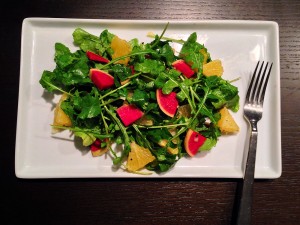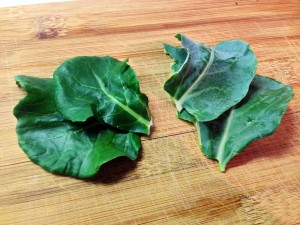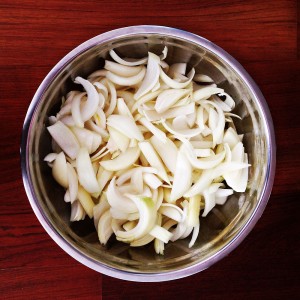As February melts into March, spring is now just around the corner here in Brooklyn. Even as winter tries to throw one more polar vortex at us, it won’t be long now before the first green shoots start popping up. Even so, we’re now entering one of the saddest times of year for fresh produce at the greenmarket, as the winter stocks of squashes and apples begin to run low while the fresh greens of early spring are still a couple months away. This is the time to turn to the canned, pickled and frozen spoils of last season’s garden, but what if you want to eat fresh? Enter the healthy winter salad.
Every year as the first freeze hits, I abandon the tomatoes, peppers and squashes to their fate, watch the berry plants go dormant, and bring in a select few herbs to form the indoor winter garden – rosemary, lavender, thyme, mint, parsley. This year in addition to carrying over the herbs I decided to start an indoor crop just for winter, and planted a box of arugula.
Arugula is an ideal mini crop to grow indoors during winter – it prefers things on the cooler side, does ok with partial sun, and has roots that don’t go too deep, making it perfect for containers (I grew mine in an old wooden wine box). Plus you get a lot of nutritional bang for your buck as arugula has high levels of phytochemicals, antioxidants, and vitamins (particularly vitamin A). When harvesting, pull the larger outer leaves off and leave a few of the tiny center ones so it keeps growing back again & again.
Arugula has a nice peppery zest to it and you can use your crop in a number of different ways – in a pesto, in pasta dishes, or of course in a fresh salad. For my salad, I combined arugula with seasonal citrus and watermelon radishes, to make a fresh, healthy, and colorful addition to a winter meal.
| Winter salad with arugula, citrus, and watermelon radishes | Print |
- 4 cups arugula, rinsed and drained
- 4 clementines or 1 large orange, peeled
- 4 large radishes (preferably watermelon variety), washed
- 1 shallot, minced
- 2 tbsp lemon juice
- 2 tbsp extra virgin olive oil
- ¼ tsp pepper
- ⅛ tsp salt (to taste)
- Make vinaigrette: Mix lemon juice, shallot, salt, and pepper in bowl. Drizzle in olive oil slowly while whisking to combine.
- Cut radishes lengthwise, then slice crosswise into thin discs.
- Separate citrus segments - for clementines, use entire segments. For oranges, cut segments in half.
- Combine arugula, radishes, and citrus. Toss with vinaigrette & serve.
- Make this salad your own: mix in other elements to make it more substantial. You can add mesclun greens, endive, fennel, pear or apple slices, chopped red onion, avocado slices, walnuts, or feta cheese.
This salad has a lot of bite to it – if it’s too much zing for your palate, you could mix in some mesclun greens, and any high fat toppings you might add such as avocados, nuts, or feta cheese will help balance and tame it as well. Or try a cooked version – sautée the radishes in oil or butter with a little salt & pepper until soft, toss in the arugula & turn off the heat so it just wilts, and add the citrus last.




